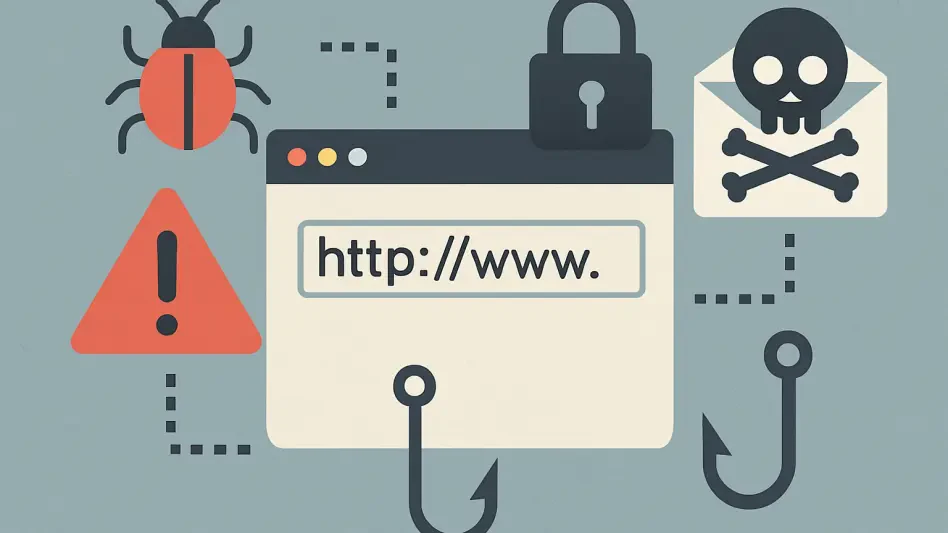In the ever-evolving landscape of cybersecurity, a striking trend has emerged that underscores the cunning adaptability of cybercriminals, who have increasingly turned to URL-based threats as their weapon of choice. These malicious links, often hidden in seemingly harmless emails or text messages, have become a dominant force in the threat landscape, outpacing traditional methods like attachment-based attacks by a wide margin. The appeal lies in their deceptive simplicity—URLs can be easily disguised and embedded across various platforms, making them a stealthy tool to exploit human curiosity and trust. Cybersecurity experts have noted that these tactics are not just about technological trickery but are deeply rooted in manipulating psychological vulnerabilities. As attackers refine their strategies with advanced social engineering and cutting-edge tools, understanding the reasons behind this preference becomes crucial for developing effective defenses against an insidious and pervasive danger.
The Dominance of URL-Based Attacks
The sheer volume of URL-based threats paints a stark picture of their prominence in the current cyber threat arena. Recent data from leading cybersecurity research indicates that these threats outnumber attachment-based attacks by a ratio of four to one, highlighting a clear shift in criminal tactics. Unlike attachments, which often trigger suspicion or are blocked by security filters, malicious URLs can be seamlessly integrated into everyday communications, such as emails or instant messages. Their ability to evade traditional detection mechanisms makes them particularly appealing to attackers seeking quick and effective results. Often, these links lead unsuspecting users to fraudulent sites designed to harvest sensitive information or initiate malware downloads. This trend reflects not only the technical advantages of URLs but also their capacity to exploit human behavior, as a single click can compromise an entire system with devastating consequences.
Beyond their volume, the sophistication of URL-based attacks reveals why they have become a go-to method for cybercriminals. These threats are frequently paired with advanced social engineering techniques, tricking users into believing they are interacting with legitimate sources. Campaigns often mimic trusted entities, embedding malicious links in contexts that appear urgent or familiar, such as notifications from banks or delivery services. The ease of disguising these URLs—whether through shortened links or embedded buttons—further enhances their effectiveness. Additionally, attackers leverage readily available phishing kits that lower the barrier to entry, allowing even less-skilled individuals to launch convincing campaigns. This accessibility, combined with the difficulty of detecting such threats in real time, ensures that URL-based attacks remain a persistent and evolving challenge for both individuals and organizations striving to maintain secure digital environments.
Credential Phishing as the Primary Goal
A key driver behind the popularity of URL-based threats is their effectiveness in credential phishing, which has emerged as the predominant objective for many cybercriminals. Billions of these attacks are launched annually with the sole aim of stealing login credentials, providing attackers with direct access to personal and corporate accounts. The tactics employed are often highly deceptive, using fake error messages or CAPTCHA screens to prompt users into taking actions that execute malicious code. Such methods prey on the natural instinct to resolve apparent technical issues, leading victims to unwittingly compromise their security. The scale of these campaigns is staggering, with some specific techniques showing exponential growth in frequency, underscoring how lucrative and accessible this form of attack has become for threat actors across the globe.
Moreover, the impact of credential phishing extends far beyond initial access, often resulting in full account takeovers that can devastate both individuals and businesses. Attackers frequently bypass even multi-factor authentication by exploiting stolen credentials to impersonate trusted brands or services, gaining deeper access to sensitive systems. The use of remote access trojans, infostealers, and other malicious tools delivered via URLs ensures that the damage is not limited to a single breach but can cascade across networks. This relentless focus on credentials highlights the human-centric nature of modern cyber threats, where psychological manipulation plays as significant a role as technological innovation. As these attacks become more refined, the need for heightened user awareness and robust security measures becomes ever more critical to counter the persistent danger posed by such deceptive tactics.
Mobile Threats and Emerging Vectors
The rise of mobile-targeted URL-based threats marks another alarming dimension of this cybersecurity challenge, as attackers increasingly exploit the personal nature of mobile devices. QR code phishing, for instance, has surged dramatically, with millions of such threats detected in recent months, redirecting users to fraudulent sites designed to steal credentials or financial data. These codes are particularly insidious because they often bypass enterprise security protections, targeting individuals on devices that are less likely to have robust safeguards in place. The immediacy and trust associated with scanning a QR code make it an ideal vector for cybercriminals looking to capitalize on user behavior, especially in contexts like public spaces or urgent communications that demand quick action.
Equally concerning is the explosive growth of smishing, or SMS-based phishing, which has seen a staggering increase in prevalence. Over half of suspected text messages now contain malicious URLs, often masquerading as legitimate communications from government agencies or delivery services. The personal and urgent tone of SMS messages amplifies their effectiveness, as users are more likely to act without scrutiny on their mobile devices. This shift toward mobile-first attacks illustrates the adaptability of threat actors, who continuously evolve their methods to exploit new technologies and user habits. As mobile devices become central to daily life, the challenge of securing these platforms against URL-based threats grows more complex, demanding innovative solutions and greater vigilance from users to stay ahead of ever-shifting dangers.
Adapting Defenses to a Human-Centric Threat Landscape
Reflecting on the pervasive nature of URL-based threats, it becomes evident that cybercriminals have honed their focus on exploiting human vulnerabilities rather than solely targeting technological weaknesses. Attackers weaponize trusted platforms and familiar user experiences, embedding malicious links across emails, collaboration apps, and mobile messages to maximize their reach. Their strategies adapt swiftly to bypass traditional security measures, capitalizing on psychological triggers that prompt users to click without hesitation. This human-centric approach marks a significant shift in the threat landscape, where the battle is fought not just in code but in the minds of unsuspecting individuals.
Looking ahead, combating these sophisticated threats demands a multi-layered, AI-powered approach to detection and prevention, coupled with a strong emphasis on user education. Organizations must invest in advanced tools capable of identifying and neutralizing malicious URLs in real time, while simultaneously fostering a culture of skepticism toward unsolicited communications. Encouraging users to verify the legitimacy of links before clicking, even under pressure, stands as a critical line of defense. As cybercriminals continue to refine their tactics, staying proactive with regular training and updated security protocols will be essential to safeguard against the relentless evolution of these deceptive and damaging attacks.








